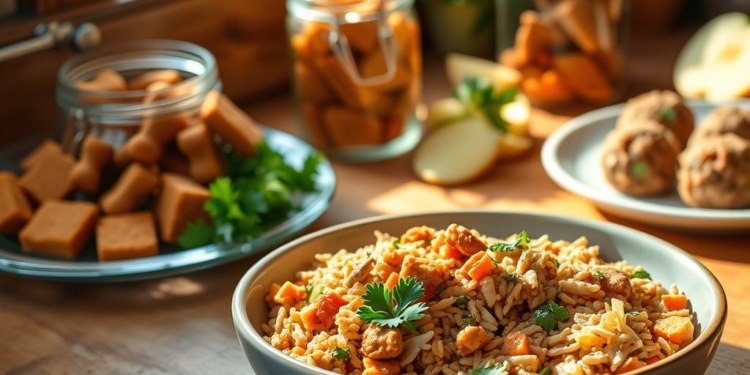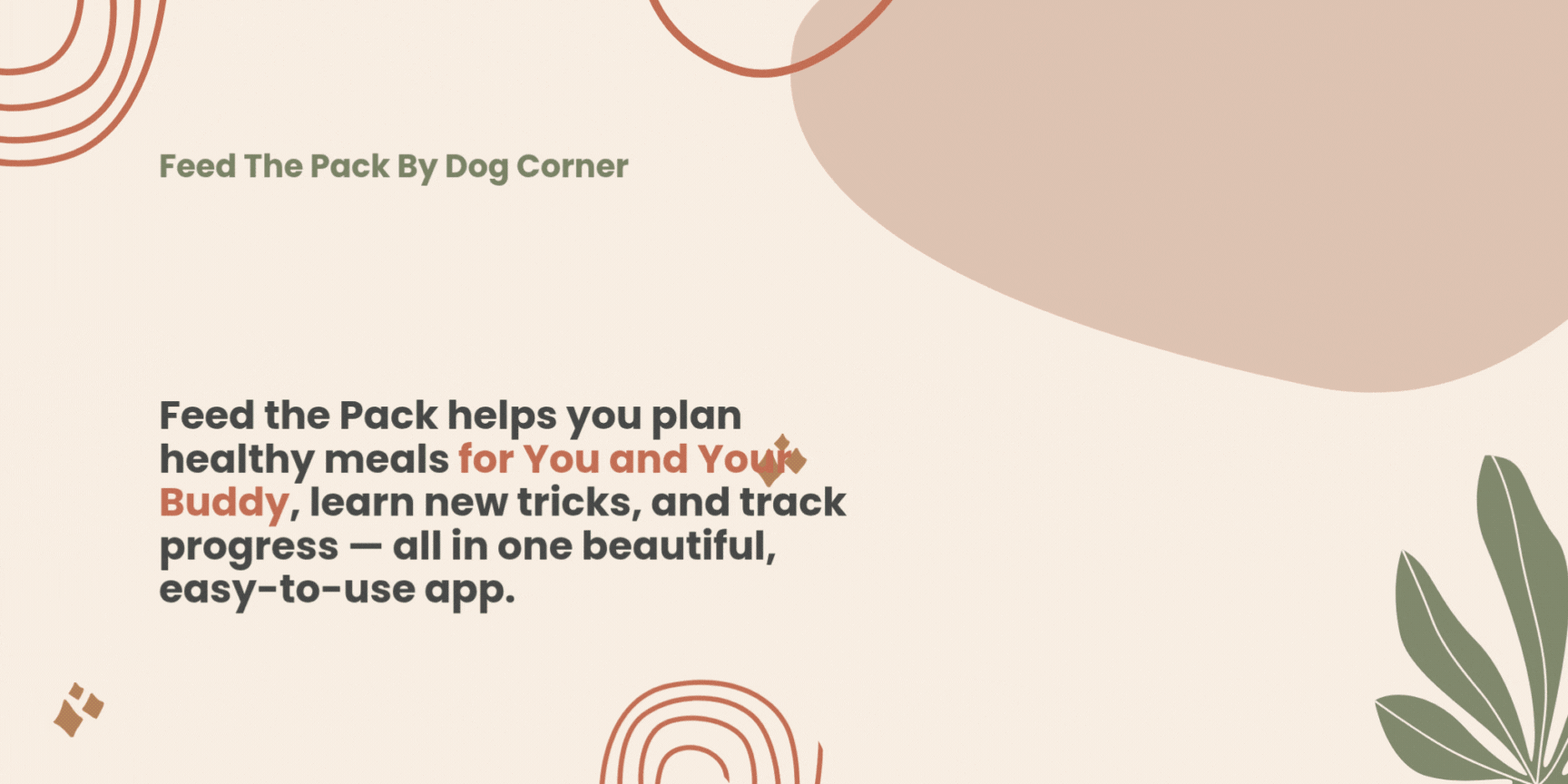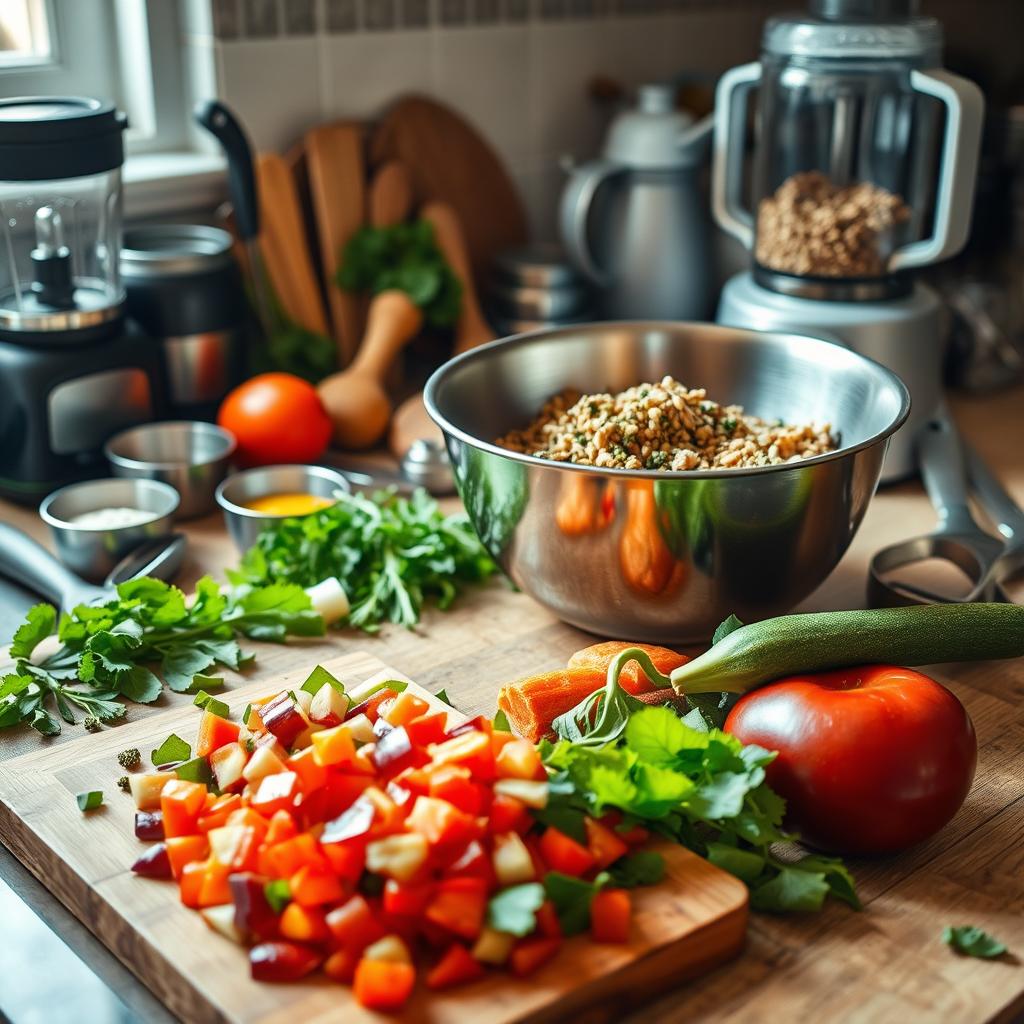Mealtime can be tough when you have a picky eater dog. Luckily, this guide has Homemade Dog Meal Ideas that are easy and healthy. They’re perfect for fussy eaters. You’ll find easy steps, budget-friendly hints, and advice that’s safe for dogs. And everything is perfect for U.S. kitchens.
These ideas come from real dogs. A Yorkie got better after switching from bad store food to a simple recipe. An 11-year-old dog named Hooch got lively with special human-grade dog food. And two Shih Tzus, Lucky and Sassy, loved the ground beef dog food from Delicious Table.
Here, there are recipes with safe veggies like carrots and sweet potatoes. There are also tips for dogs with allergies and advice on bone broth. Plus, we talk about making big batches and how to store them.
Small things can make a big difference for picky eaters. Try warming their food or changing the meat sometimes. Starting with something like a pumpkin dog recipe might work well. These are balanced but simple.
It’s key to talk to your vet first. Don’t mix raw and cooked food, and pick fresh ingredients. Let’s aim to make dinner time happy again. Choose meals that your dog will enjoy eating.
Why Homemade Can Win Over a Fussy Dog
Fresh, warm, and aromatic meals can lure a picky eater. Human-grade meals let owners choose flavors, textures, and warmth. This means homemade dog food has less filler, no harsh chemicals, and ingredients dogs love.
Many say homemade dog food brings quick improvements. This Mess is Ours shows making 100% human-grade food is budget-wise and gave their old dog Hooch more energy. Delicious Table adds that ditching shelf-life extenders makes crafting allergy-friendly meals at home easier, benefiting dogs with sensitive stomachs.
Taste and texture are important. Mixing ground beef, broth-cooked rice, and thinly cut vegetables makes meals dogs can digest easier. A small Shih Tzu named Sassy shows us that dogs prefer certain textures, like finely chopped beef over whole spinach leaves.
Making food at home means you can change proteins easily to avoid allergies. It’s easier to steer clear of dairy or chicken this way. Homemade food is often more tempting for dogs than store-bought because of its fresh scent and moisture.
Some dogs need extra attention. For kidney issues, vets suggest meals low in phosphorus, smaller portions, and nutritious fluids like bone broth. It’s important to keep raw and cooked meals apart for health and digestion, as many vet-approved diets recommend.
Changes can happen fast. A Yorkie stopped itching the day it switched from bad store food to home-cooked meals. Home-made meals that are warm, moist, and smell familiar make dogs want to eat up, leaving clean bowls and happy bellies.
Homemade Dog Meal Ideas
Here are seven simple, cozy meal ideas that picky dogs will love. They use whole foods and easy ways to prepare them, following recipes from sites like This Mess is Ours, Damn Delicious, and College Housewife. Change up the flavors to keep your dog excited, and introduce new foods slowly.
Ground Beef & Brown Rice Bowl with Carrots and Parsley
Create a ground beef dish for dogs that’s tasty and light on the stomach. Mix 6 cups of cooked brown rice, 2 pounds of lean ground beef or sirloin, shredded carrots, and minced curly parsley together. Heating it up makes it smell amazing. Make sure to drain the fat and add a bit of olive or safflower oil for a healthier option.
Turkey, Sweet Potato, and Zucchini Skillet for Sensitive Bellies
If beef is too heavy, try this ground turkey dog recipe. Cook ground turkey and mix it with sweet potato, carrots, and finely chopped zucchini. You can add a bit of macaroni for carbs if your dog can handle it. This recipe keeps everything small and easy to eat for dogs who are picky about textures.
Hydrating Beefy Rice with Bone Broth for Added Fluids
Cooking rice in dog-friendly stock turns it into a moist, bone broth meal. Always choose low-sodium options and avoid onions. Add soft beef and more broth before serving for extra hydration. This meal is great for dogs that need more fluids and enjoy soft foods.
Pumpkin and Yogurt Breakfast Bowl for Gentle Mornings
Start the day with a pumpkin and yogurt dog breakfast. Use fat-free Greek yogurt and 100% pumpkin puree. Sprinkle dog-safe herbs, like parsley or dill, on top for flavor. It’s gentle on the stomach and gives your dog steady energy.
Slow Cooker Comfort Mix: Beef, Brown Rice, Kidney Beans, and Veggies
Make an easy slow cooker meal with ground beef, brown rice, carrots, peas, and squash. Add a few kidney beans for fiber and protein. It’s a well-rounded meal that’s easy to serve and reheat.
Egg-Boosted Sirloin Mix (Vet-Supervised, Allergen-Aware)
If your vet says it’s okay, mix sirloin, rice, carrots, and omega-rich oil with an egg boost. Include diced hard-boiled eggs for more protein when safe. If eggs aren’t okay for your dog, keep it simple without them.
Fall Harvest Feast: Sweet Potato, Cranberries, Rosemary, and Sage
Enjoy the flavors of fall with a sweet potato, cranberry, rosemary, and sage dog meal. Cook sweet potatoes until soft, then mix in chopped cranberries and a bit of dog-safe herbs. Serve it warm for a meal that smells great and is full of goodness.
Ingredient Swaps That Help With Allergies and Picky Preferences
Smart swaps help with dog food allergies and picky eaters. Change one thing at a time to see what helps. Keep track, be patient, and rotate proteins to keep meals interesting and healthy.
Proteins to Rotate: Beef, Turkey, Chicken, Pork, Lamb, Fish, Eggs
Try rotating lean beef, turkey, chicken, pork, lamb, fish, and eggs. Rotating proteins helps find what triggers allergies and keeps meals fresh. For sensitive dogs, start with turkey or lamb as they’re gentler. If your dog needs kidney support, pick low-phosphorus meats and talk to your vet.
Digestible Carbs and Grains: Brown/White Rice, Oats, Quinoa, Pasta
Change up grains to help your dog’s digestion. Brown rice is high in fiber; white rice is easier on stomachs. Oats, quinoa, and whole-grain pasta give lasting energy. Choose rice or quinoa for gluten-sensitive dogs. Cooking rice in beef or vegetable broth is good if chicken bothers your dog.
Dog-Friendly Veggies: Carrots, Green Beans, Peas, Broccoli, Pumpkin
Give your dog safe veggies, like carrots, green beans, peas, and chopped broccoli. Mix in 100% pumpkin for fiber. Try zucchini or butternut squash for something different. Avoid raw potatoes and big broccoli stems to prevent problems.
Flavor and Function: Curly Parsley, Basil, Cilantro, Thyme
Herbs make dog food smell and taste better without too much salt. Use curly parsley, basil, cilantro, or thyme. Parsley can help healthy dogs’ kidneys but use it in moderation if your dog has kidney issues. A little herb mix keeps food exciting while you watch for allergies.
Healthy Fats and Omegas: Olive or Safflower Oil, Fish Oil
Add a bit of olive or safflower oil for shine and taste. Omega oils, like fish oil, are good for your dog’s skin and coat. Start small to avoid stomach upsets. Balance fats with lean meats and simple grains for stable meals.
What to Avoid: Onions, Garlic, Raw Sweet Potato, Mixing Raw with Cooked
Avoid foods that are toxic to dogs, like onions and garlic. Only use cooked sweet potatoes. Be careful with raw and cooked foods together. If unsure, keep things simple and change one thing at a time. This helps you spot dog food allergies.
Prep Methods That Boost Acceptance
Texture and scent are key to get a picky dog to eat. When making homemade dog food, aim for warmth and softness. Chop meat small, and if necessary, pulse it to get finely chopped meals. These are easy for dogs to chew and digest.
Getting timing right with Instant Pot dog food is smart. Start with hard-boiled eggs cooked on high for 5 minutes, then let them release naturally. Next, use the rice function to cook rice in broth for dogs. While the rice cooks, brown some lean sirloin and prepare fresh add-ins. This way, everything is ready quickly and served warm.
Dogs often skip food with big pieces of vegetables. Finely grate or process carrots, zucchini, and spinach for better blend and intake. Sauté carrots, broccoli, and sweet potatoes until just tender. This releases a tempting aroma for picky dogs without losing the healthy stuff.
Flavoring is key when you make rice in broth for dogs. Use beef stock or low-sodium bouillon, but skip salt if you use bouillon. Mix the warm rice with the meat and soft veggies for a dish that smells great. This encourages dogs to start eating and keeps them going.
A slow cooker dog recipe is a great “set-and-forget” method. Use beef, brown rice, kidney beans, carrots, peas, and squash. Slow cooking makes everything tender and smells wonderful. Remember to keep seasonings safe for dogs—avoid onion and garlic. Always serve the food warm, not hot.
Pay attention to fat. Drain the extra grease, leaving just a bit for flavor and energy. Finely chop the meat, especially for seniors and small dogs. This makes every bite consistent. These little changes make meals like Instant Pot dog food or slow cooker recipes appealing to fussy eaters.
Portions, Storage, and Cost-Saving Tips
A simple plan is key when feeding from your kitchen. This guide ensures meals are steady, safe, and budget-friendly. It’s important to measure accurately, label, and adjust based on your dog’s age and energy levels.
How Much to Feed: Rough Guide by Dog Weight
Begin with the dog’s weight to figure meal sizes: roughly 1 cup of food for each 10 pounds of weight per day. For example, a 40-pound dog typically eats 4 cups a day, split into two meals. A dog weighing 80 pounds usually has 8 cups daily, also in two servings.
Calories can differ. Factors like age, breed, and exercise alter needs, so tally up the daily calories. Always check with your vet. For dogs with kidney issues, many small meals throughout the day can help.
Batch Cooking and Freezing in Flat Bags for Freshness
Make food in big batches and cool. Then, put it into flat zip-top bags. Flatten them for quick cooling and neat stacking. This method keeps the food fresh and tasty after freezing.
Always have one bag in the fridge thawing, rotating roughly every five days. For tiny dogs, freezing smaller portions extends shelf life past a week. Usually, you’ll get about 13 cups from a batch, each cup containing around 288 calories. This makes planning easier.
Making It Budget-Friendly vs Store-Bought Options
With wise shopping, homemade dog food costs less. About $20 spent on ingredients can yield near 40 cups, costing fifty cents each cup. This competes with many dry dog foods in price, but homemade meals offer better control over what your dog eats.
To save, use up what’s in your freezer, pick seasonal veggies, and bulk up meals with a bit of premium dry food or beans if your dog can handle them. Freezing meals cuts down on waste and stabilizes weekly food expenses.
Soft, Finely Chopped Meals for Senior or Small Dogs
For older dogs, focus on easy-to-eat textures. Use a food processor to finely chop cooked meats and veggies. This eases chewing and helps with fussy eaters.
Always warm meals slightly, never serve them hot. Warming a cup for about 30 seconds can make food more appealing. Serve in small, moist portions to keep eating easy and consistent.
Real-Life Wins: From Itchy Skin to Clean Bowls
Making small changes at home can lead to huge improvements. Stories of dogs overcoming allergies highlight this well. They show that with homemade recipes, wise shopping, and cooking with care, picky dogs can truly change. By managing what goes into their food, owners see benefits comparable to high-value dog diets. This is especially true after issues with spoiled store-bought pet food.
Yorkie Relief After Switching from Spoiled Packaged Food
A family threw away a bad-smelling packaged meal despite its valid date. They took action after realizing the food was spoiled and went to H‑E‑B for simple ingredients. A bath and a homemade meal of rice, beef, and parsley stopped their Yorkie’s itching fast. It’s a perfect example of quick relief from allergies through smart meal prep.
Senior Dog “New Lease on Life” with Human-Grade Meals
This Mess is Ours tells a tale of Hooch, an eleven-year-old dog, and his remarkable recovery. He thrived on a diet of sirloin, rice, carrots, eggs, and oils rich in omega, all human-grade. His dishes went from ignored to empty, showing a true transformation. Owners noticed his energy levels were consistent and his digestion improved. These changes became evident in his daily life.
Allergy Workarounds: Beef Instead of Chicken, Broth Choices
Delicious Table found a solution for their Shih Tzus allergic to chicken. Cooking with ground beef and rice in beef stock worked wonders. This adjustment helped avoid allergic reactions while keeping meals tasty. The College Housewife offered a turkey-based alternative for dogs who couldn’t have beef. This highlights how switching proteins and broths can make mealtime better.
These stories emphasize the importance of mindful meal prep: choosing the right protein, selecting appropriate broths, and keeping food fresh. By cautiously modifying their diets and keeping a vet informed, feeding time becomes a pleasant experience. Each meal moves from being a challenge to a joy.
Safe Hydration and Nutrition Enhancers
Add-ins that are moist and gentle make it easier for dogs to eat everything in their bowl. These add-ins are good for keeping your dog hydrated, comfortable, and energized. They’re perfect for creating meals that help with hydration and boosting your dog’s immune system without upsetting their stomach.
Bone Broth Made for Dogs: No Onions, Added Immune Support
When making dog bone broth, keep it simple and safe: avoid onions, garlic, and salty, store-bought options. Trusted pet cooks might check out This Mess is Ours for recipes using beef or turkey bones with apple, ginger, or mushrooms. You can cook it on the stove, in an Instant Pot, or a slow cooker.
This broth adds flavor and hydration to your dog’s meal. Owners also find it provides benefits like immune support, digestion aid, and joint comfort. For dogs with issues from chicken stock, Delicious Table suggests beef broth might be gentler.
Add a bit of olive or safflower oil for a shiny coat and fish oil for more omegas. Always consult your vet before adding any supplements to your dog’s diet.
Pumpkin for Fiber and Digestion
Make sure to use 100% pumpkin puree, not the pie kind. Adding a spoonful or two to each meal can help your dog’s stomach and support digestion. It’s good mixed with yogurt and a vitamin-mineral blend for a smooth start to the day.
Pumpkin adds fiber to your dog’s diet and keeps the food moist. This is great for dogs that are hard to please and works well with bone broth in hydrating meals.
Small, Frequent Meals for Kidney Comfort
Dogs with kidney issues benefit from smaller meals spread out over the day rather than one big meal. This method eases their kidney work and helps keep their fluid levels stable.
Broth can make every meal more appealing, and talking to your vet about low phosphorus options could help adjust proteins and minerals. Combine gentle proteins with pumpkin to keep your dog’s meals comforting and regular.
Conclusion
Creating meals for your dog at home gives you total control over what they eat. You can make sure the meals meet your dog’s specific needs for nutrients and hydration. Plus, you’ll likely notice your dog enjoying their food more, with clearer skin and brighter eyes.
Many dog owners have seen big improvements. Dogs with itchy skin get better once they stop eating commercial food. Older dogs become more lively with meals fit for humans. And if your dog is picky, trying different proteins and broths can help with any digestive issues.
To start, make simple meals with lean meats like beef or chicken. Combine them with easy-to-digest grains such as rice or oats. Include dog-safe veggies like carrots and peas, and add a bit of pumpkin for fiber. Flavor the meal with herbs like parsley and add some omega-rich oil.
Keep the food moist by adding some bone broth but remember to keep onions and garlic out. It’s also important not to mix raw foods with cooked ones for safety.
Generally, dogs should eat about 1 cup of food per 10 pounds of their weight each day. But, you’ll need to adjust this based on how old your dog is, how much they exercise, and their overall health. For dogs with kidney issues, serve smaller meals more often and make sure they get plenty of water.
If your dog has allergies, you can easily swap out certain ingredients. Cooking large batches of food ahead of time and freezing it can save time and keep the food fresh. This approach can also be quite cost-effective.
It’s crucial to be consistent with what you feed your dog and to keep your vet informed. If your dog has special dietary needs, consider consulting with a veterinary nutritionist. By sticking to a routine and making smart food choices, you can make mealtime a joy for both you and your dog.
These efforts ensure your dog not only loves their meals but also enjoys better health from them. Paying attention to portion sizes and how you store the food can further enhance the benefits of home-cooked dog meals.


















































Discussion about this post